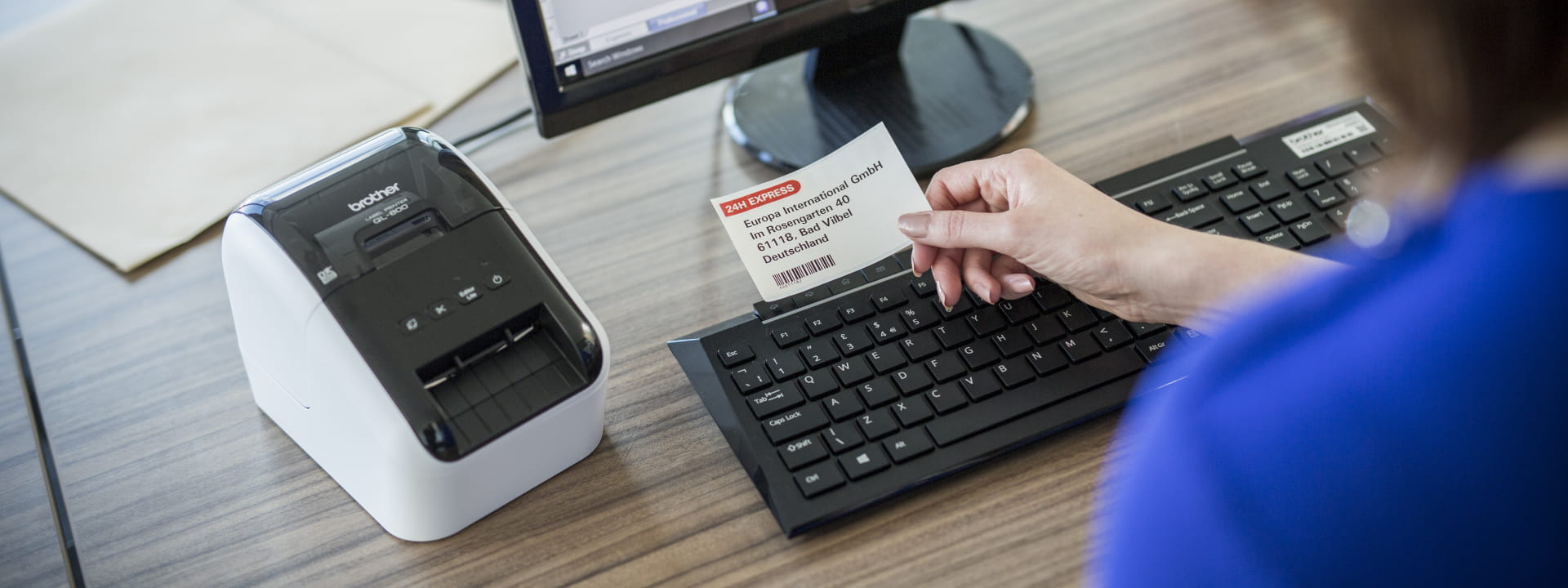
Thermal label printers employ heat instead of ink to generate labels and signage on various materials such as paper, tape, ribbon, and others. Two types of thermal printing exist: direct thermal and thermal transfer.
Thermal printing (or direct thermal printing) selectively applies heat to thermal paper as it passes through the thermal print head, causing the heat-sensitive coating of the paper to turn black in the heated areas and create the desired image.
In contrast, thermal transfer printing uses a heated ribbon to produce durable and long-lasting images. This process excels at creating highly resilient prints resistant to smudging. Consequently, thermal printers have gained popularity for producing enduring labels, easily scannable barcodes, till receipts, tickets, wristbands, vouchers, name badges, and more.
Labels and signs play a ubiquitous role in our daily lives, both personally and professionally. They are found in homes, offices, shops, warehouses, and various other facilities. Thermal labels have become essential in a wide range of industries, including electricians and network, retail, healthcare, and food traceability. In the face of the challenges brought about by the COVID-19 pandemic, ensuring a safe and efficient workplace operation has become paramount. Therefore, having quick access to workplace and safety labels has never been more crucial. If you require high-quality, cost-effective labels that are durable (thermal transfer) or suitable for short-term applications (direct thermal), thermal printing is an excellent choice.
How does a thermal label printer work?
A thermal label printer operates based on the principles of either direct thermal or thermal transfer printing. In direct thermal printing, a specialized thermochromic-coated paper is used, while thermal transfer printing utilizes a heat-sensitive ribbon for added durability. Thermal transfer printers feature a printhead consisting of small heated pins, with each pin corresponding to a pixel. These pins are controlled by a microprocessor, which determines the necessary pins to form the desired image. Heat is applied to melt and transfer wax or resin-based ink from the ribbon onto a blank surface, such as paper, plastic, or other materials.
There are three main types of thermal transfer inks available: wax, wax-resin, and pure resin. Each type possesses distinct characteristics. Wax ink offers long-lasting results, but labels printed with this ink should remain dry and avoid exposure to oils, chemicals, and abrasives. Wax-resin ink provides enhanced durability and is often used for precise image printing. Pure resin ink is the most resilient, offering waterproof and sunlight-resistant properties, as well as increased protection against chemicals and oils. However, pure resin ink cannot be used on paper and is specifically designed for materials like vinyl, polyester, polypropylene, and others, making it suitable for highly durable labels and signs in sectors such as automotive, marine, aircraft, transport, and engineering.
The choice of ink depends on specific business or personal requirements, as does the selection of printing materials. Brother offers a wide range of media options for printing, including custom labels, catering to diverse labelling needs. From the exceptionally durable P-touch range to full-color, desktop, and portable options, there is a thermal label printer available for every task.
What are the advantages of a thermal label printer?
One significant advantage of thermal printing is the versatility it offers beyond paper. Depending on the chosen printer, thermal label printers can accommodate various tapes, ribbons, and materials like plastic, nylon, polyester, vinyl, and even heat shrink tubing. This flexibility makes thermal printers highly adaptable for a wide range of industries and applications.
Furthermore, durability is an important consideration for certain uses of thermal label printers. Labels produced through thermal transfer exhibit far greater resilience compared to traditional ink on paper printing. Ink can easily bleed, smudge, and fade over time and exposure to environmental elements. In contrast, thermal prints demonstrate superior resistance, particularly when using pure resin combined with laminated materials.
Brother's distinctive P-touch labels (TZe) feature a specially designed laminated top layer that ensures longevity, whether used indoors or outdoors. These labels have been expertly engineered to withstand water, sunlight, chemicals, abrasion, and temperature variations, providing exceptional durability.
Thermal label printers excel in producing clear and easily scannable barcodes, making them an essential choice for businesses. Additionally, Brother's industry-leading QL and TD range of thermal label printers are optimized to seamlessly integrate with the latest computer and mobile technologies. They are compatible with smartphones, tablets, Wi-Fi, and Bluetooth, providing maximum flexibility. Furthermore, you can leverage label design apps for desktop and mobile platforms, as well as software development kits (SDKs), to seamlessly incorporate thermal printers into your own applications. This customization allows you to tailor the printing options according to your specific labelling requirements.
Brother's award-winning thermal label printers offer high-volume, low-cost labelling solutions while delivering exceptional durability and efficiency. With over 30 years of experience in developing professional label machines, Brother has the expertise to meet all your labelling needs.
If you are considering a thermal label printer for your organization or personal use, we recommend exploring Brother's QL-800 Series Professional Label printer range, renowned for its unmatched speed, connectivity, and versatility. It offers features like printing two-color labels in black and red. Additionally, you can explore the TD printers for high-volume printing requirements. For clear and cost-efficient labels that you can trust, thermal label printers are the top choice for a reason.
Brother International Gulf FZE offers a wide range of multifunction printers, scanners, sewing machines, and label printers. As the central hub, it manages a vast network of authorized distributors across the Middle East, Levant, and substantial parts of Africa, including North Africa, ensuring accessibility and distribution.




